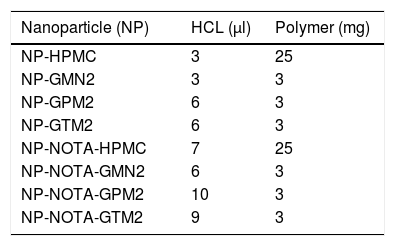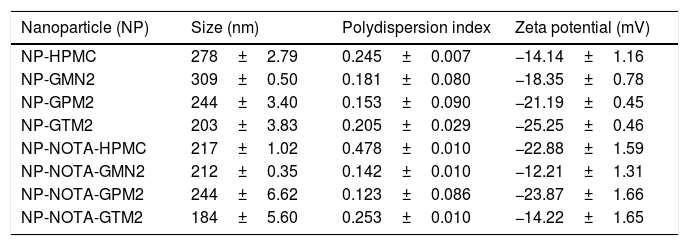To optimize radiolabeling with 99mTc and 67Ga of albumin nanoparticles coated with 4 differents synthetic polymers and to evaluate their stability in vivo and in vitro, as well as their biodistribution in vivo after intravenous administration.
Material and methodsThe nanoparticles were prepared using albumin and NOTA-modified albumin by the desolvation met-hod and coated with 4 different polymers: HPMC, GMN2, GPM2 and GTM2. They were purified, lyophilized and characterized. Radiolabelling with 99mTc was performed with 74MBq of 99mTc sodium pertechnetate, previously reduced with and acid solution of tin chloride at different concentrations (0.003, 0.005, 0.007, 0.01, 0.05 and 0.1mg/ml) and at different times (5, 10, 15, 30 and 60min) and temperatures (room temperature, 40°C and 60°C). Radiolabelling with 67Ga was performed by incubation of the nanoparticles with 37MBq of 67gallium chloride (obtained from commercial gallium-67citrate) at different times (10 and 30min) and temperatures (room temperature, 30°C and 60°C), and posterior purification with microconcentrators. The radiochemical purity was evaluated by TLC. Stability studies of radiolabeled nanoparticles in physiological serum and blood plasma were performed. Biodistribution studies of nanoparticles coated with GPM2 polymer were carried out in Wistar rats after intravenous administration of the nanoparticles. Control animals were carried out with 99mTc sodium pertechnetate and 67Ga chloride. To do so, the animals were killed and activity in organs was measured in a gamma counter.
Results99mTc labeling was carried out optimally with a tin concentration of 0.007mg/ml for the GPM2 nanoparticles and 0.005mg/ml for the rest of the formulations, with a radiolabelling time of 10min at room temperature. In the case of 67Ga the label was optimized at 30°C temperature and 30min of incubation. In both cases the radiochemical purity obtained was greater than 97%. The nanoparticles showed high stability in vitro after 48h of labeling (70% nanoparticles labeled with 99mTc and 90% those labeled with 67Ga). Biodistribution studies of nanoparticles 99mTc-GPM2 and 67Ga-NOTA-GPM2 showed a high accumulation of activity in the liver at 2 and 24h after intravenous administration.
ConclusionThe labeling procedure with 99mTc and 67Ga of albumin and albumin modified with NOTA nanoparticles allows obtaining nanoparticles with high labeling yields and adequate in vitro stability, allowing their use for in vivo studies.
Optimizar el radiomarcaje con 99mTc y 67Ga de nanopartículas de albúmina recubiertas con 4 polímeros sintéticos distintos y evaluar su estabilidad in vivo e in vitro, así como su biodistribución in vivo tras su administración intravenosa.
Material y métodosLas nanopartículas se prepararon empleando albúmina y albúmina modificada con NOTA mediante el método de desolvatación y se recubrieron con 4 polímeros distintos; HPMC, GMN2, GPM2 y GTM2. Se purificaron, liofilizaron y caracterizaron. El marcaje con 99mTc se realizó con 74MBq de pertecnetato [99mTc] sódico previamente reducido con una disolución ácida de cloruro de estaño a diferentes concentraciones (0,003; 0,005; 0,007; 0,01; 0,05 y 0,1mg/ml), a distintos tiempos (5, 10, 15, 30 y 60min) y temperaturas (temperatura ambiente, 40°C y 60°C). El marcaje con 67Ga se llevó a cabo mediante incubación de las nanopartículas con 37MBq de cloruro de 67Ga (obtenido a partir de citrato de 67Ga comercial) a distintos tiempos (10 y 30min) y temperaturas (temperatura ambiente, 30°C y 60°C) y posterior purificación con microconcentradores. La pureza radioquímica de ambos marcajes se evaluó mediante TLC. Se llevaron a cabo estudios de estabilidad de las nanopartículas marcadas en suero fisiológico y plasma sanguíneo. Los estudios de biodistribución de las nanopartículas recubiertas con el polímero GPM2 se llevaron a cabo en ratas Wistar tras la administración intravenosa de las nanopartículas. Se realizaron animales control con pertecnetato [99mTc] sódico y cloruro de 67Ga. Posteriormente, los animales fueron sacrificados y se midió la actividad de los órganos en un contador gamma.
ResultadosEl marcaje con 99mTc se llevó a cabo de forma óptima con una concentración de estaño de 0,007mg/ml para las nanopartículas GPM2 y de 0,005mg/ml para el resto de formulaciones, con un tiempo de marcaje de 10min y a temperatura ambiente. En el caso del 67Ga el marcaje se optimizó a 30°C de temperatura y 30min de incubación. En ambos casos, la pureza radioquímica obtenida fue superior al 97%. Las nanopartículas presentaron una elevada estabilidad in vitro pasadas las 48h del marcaje (70% las nanopartículas marcadas con 99mTc y 90% las marcadas con 67Ga). Los estudios de biodistribución de las nanopartículas [99mTc]-GPM2 y [67Ga]-NOTA-GPM2 mostraron una elevada acumulación de actividad en el hígado tanto a las 2h como a las 24h de la administración intravenosa.
ConclusiónEl procedimiento de marcaje con 99mTc y 67Ga de nanopartículas de albúmina y albúmina modificada con NOTA permite la obtención de nanopartículas con elevados rendimientos de marcaje y una adecuada estabilidad in vitro, permitiendo su utilización para la realización de estudios in vivo.
Article
If you experience access problems, you can contact the SEMNIM Technical Secretariat by email at secretaria.tecnica@semnim.es or by phone at +34 619 594 780.

Revista Española de Medicina Nuclear e Imagen Molecular (English Edition)












